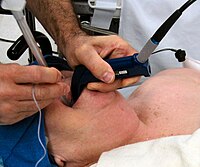
Photo from wikipedia
Awake fibreoptic intubation has been considered the technique of choice when managing many types of predicted difficult airway. In principle, if a patient is maintaining the patency of their own… Click to show full abstract
Awake fibreoptic intubation has been considered the technique of choice when managing many types of predicted difficult airway. In principle, if a patient is maintaining the patency of their own airway, there is a margin of safety which is lost if general anaesthesia is induced before the trachea is intubated. Despite this, the Fourth National Audit Project of the Royal College of Anaesthetists (NAP4) reported that awake fibreoptic intubation was not used as the primary airway plan for many highrisk patients [1]. However, awake fibreoptic intubation is a complex skill requiring regular practice to maintain competence. It is easy to see how this potentially difficult task, performed on a high-risk patient group, in departments where numbers of awake fibreoptic intubations may be low, may pose a problem; and in consequence, it is understandable that an anaesthetist might opt for a more familiar, but less appropriate, technique [1]. It is of course also true that awake fibreoptic intubation is not suitable for tracheal intubation in all patients with airway problems, and it is not always successful; NAP4 demonstrated that it failed for a variety of reasons. Most commonly these were airway obstruction, lack of patient co-operation and difficulty recognising airway anatomy due to excess secretions, blood or suction failure [1].
Journal Title: Anaesthesia
Year Published: 2018
Link to full text (if available)
Share on Social Media: Sign Up to like & get
recommendations!